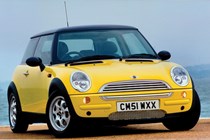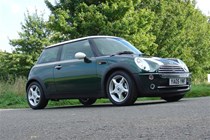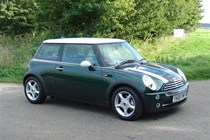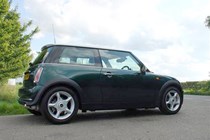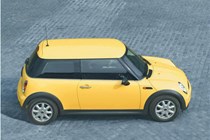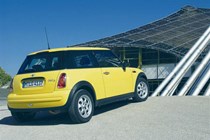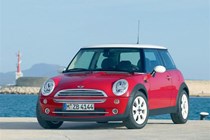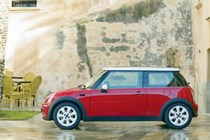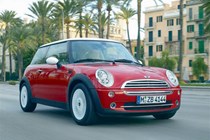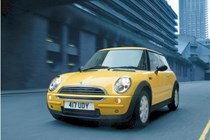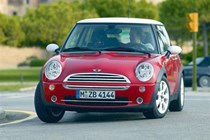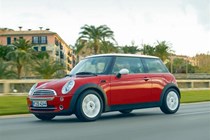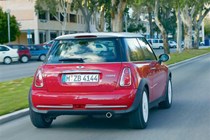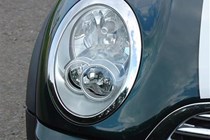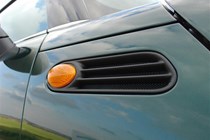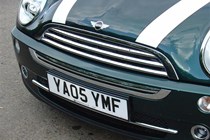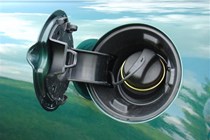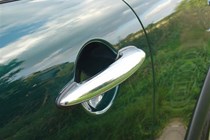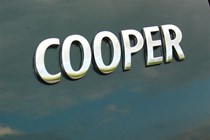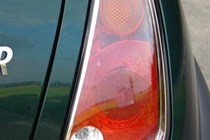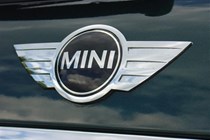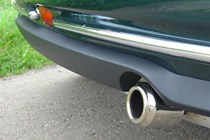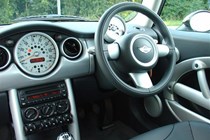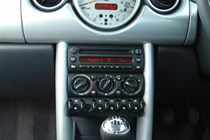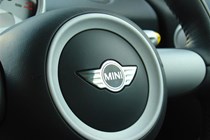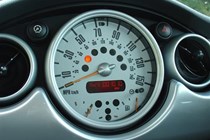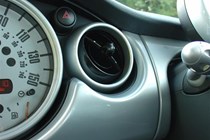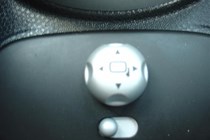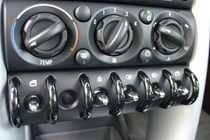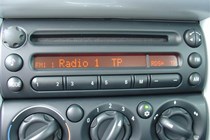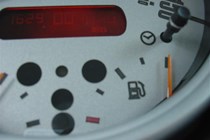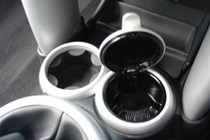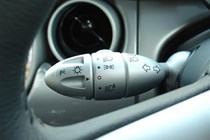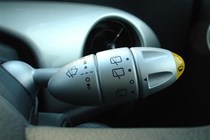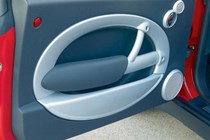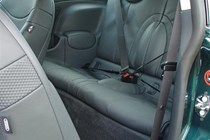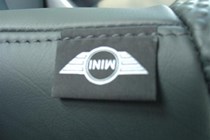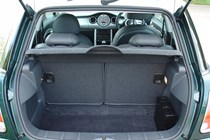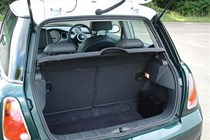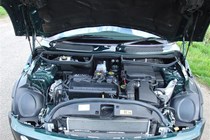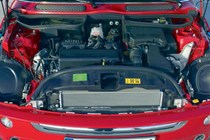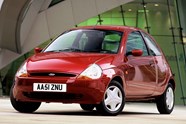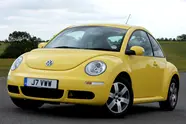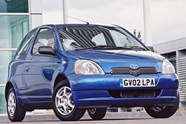MINI Hatchback Hatchback (2001-2006) review
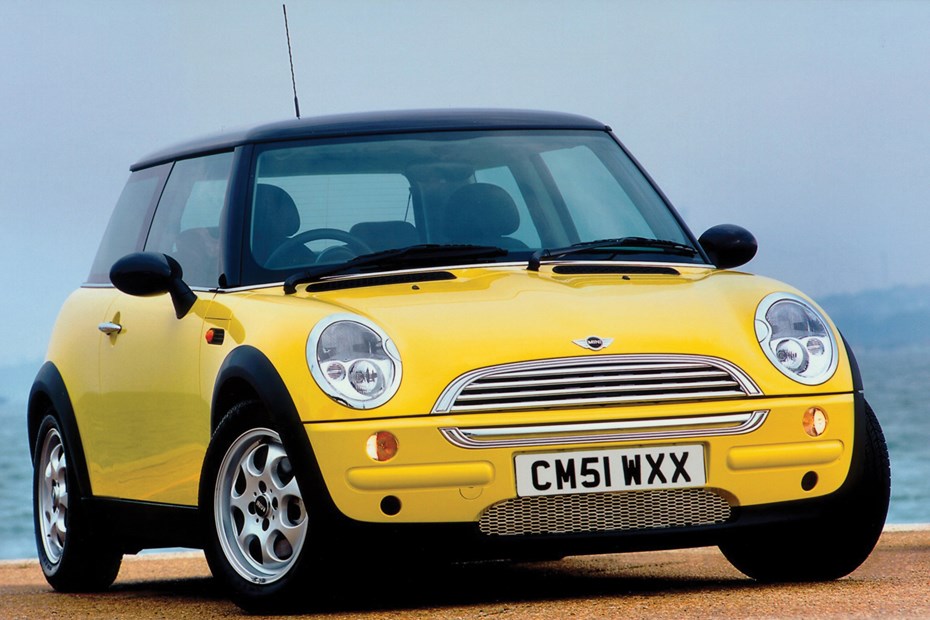
At a glance
| Price new | £10,380 - £16,160 |
|---|---|
| Used prices | £577 - £2,962 |
| Road tax cost | £165 - £395 |
| Insurance group | 12 - 22 |
Get an insurance quote with

|
|
| Fuel economy | Not tested to latest standards |
| Range | 396 - 638 miles |
| Number of doors | 3 |
| View full specs for a specific version | |
Available fuel types
Petrol
Diesel
Pros & cons
- Looks great and has aged well
- Great handling
- Cheap insurance versions
- Cramped rear seats
- Miniscule boot
- Sluggish diesel engine, weak gearboxes
MINI Hatchback (01-06) rivals
Overview
The Mini story begins in 1959, with a car that came to exemplify the swinging sixties of British fashion, music and youth culture. An advanced front-wheel drive small car it proved so beloved that it outlived every attempt to replace it until the 21st century, when this – the MINI Hatchback – brought the brand back to showrooms.
The first generation, known as R50, launched officially in 2001 and though it is much larger than the original Mini’s 3.04-metre length and 1.5-metre width, it’s also much less of a compromised design and remains a great used car for first-time buyers.
You will find original MINI Hatchbacks for sale in small dealers and through classified adverts primarily, and they are all three-door models with a focus on front-seat comfort. The range expanded with the R52 Convertible and the R53 supercharged Cooper S performance model, but the needs of families were met with less-mini MINIs such as the Clubman and Countryman.
You could be considering a Fiat 500, Fiat Panda or a VW New Beetle if you’re drawn to the MINI’s retro looks, but it’s equally valid as an alternative to a Kia Picanto, three-door Ford Fiesta Mk6, or a Vauxhall Corsa or Adam. Against those rivals it generally scores on style and handling, but it’s quite well-made too.
The MINI is also a good car for young car enthusiasts. It is not as simple, mechanically, as the original but it does have good access to the engine, an enthusiastic following, and an already recognised place in Britain’s car culture. It’s also relatively cheap to insure and easy to drive, while being usefully safer than many comparable cars of the same age.
New MINI Hatchback (R50) buying guide
There are three basic variations of MINI – One, Cooper, and One Diesel. The petrol models are 1.6-litre, the diesel a 1.4-litre and we’d avoid it now. There is an automatic option, but if you are buying it to learn in that does mean being limited to automatics unless you take a test in a manual car.
With the youngest cars approaching two decades old, all but the most cherished examples are going to be a bit shabby and tired. Choosing a good one depends on your own priorities, but we’d look for mechanical maintenance over appearance, and if buying as a young driver pay particular attention to when the clutch was replaced and how good the tyres and brakes are.
MINI Hatchback (R50, 2001-2006) known faults and common problems
As a rule, the newer the first-generation MINI you go for, the better the build quality will be, but some features may have been removed over early ones. Before looking at any used MINI check the MOT history online and if it looks like it’s been cared for or modified, or has stickers identifying car clubs, do a couple of searches for forums or Facebook Pages that might reveal good or bad aspects of its history.
Because these are popular with learner drivers and as first cars pay particular attention to the condition of the wheels and tyres, look for uneven wear, kerbing damage (or cheap multi-fit alloys) and mismatched/cheap brands. Before hitting marketplace and eBay, check out some common car scams to avoid as well.
1. MINI One and Cooper – bodywork and trim
Good news if you’re a fan of classic Minis – the New MINI is very resistant to rust and generally only does so if really neglected. With the oldest examples carrying well over 20 years of use there’s plenty of opportunity for neglect, we’d check the rear edges of the sills, around the front bumper and exposed metal when the bonnet is open, and look at the panels and arches for surface rust or bubbles forming.
Trim can detach around the windscreen and roof edges, and the condition of accessories such as spotlights, stickers and chrome covers may deteriorate faster than the factory-fitted equipment. Most parts are still available new, but not cheap.
2. MINI (R50) interior trim and switches
A big part of the MINI’s appeal is the stylish and high-quality interior. Toggle switches, a central speedometer and generous use of chrome lets it feel a cut above the grey plastics of rivals, but not all of the trim is long-lasting. Gear knobs can wear leaving sharp edges, door trims can be damaged by repairs or careless owners, and aftermarket accessories will often leave marks. Seats wear well, but the rear seats and trim may bear the scars of being used to carry cargo due to the small boot.
If buying as a modern classic (or you just like to get enthusiastic about your car) familiarise yourself with the differences between early and late cars to make sure your prospective purchase has the features you want intact, such as stylish rubber pads on the pedals. Quality and sound reduction was slowly reduced over the years to make the MINI more profitable, so early ones are worth seeking out.
3. Water leaks and damp issues
MINIs have frameless front windows which can seal badly and leak, but most leaks come from the back of the car via the lights and tailgate handle trim. Seals are easy to replace, but if left damp for a prolonged time the material and sound deadening may be hard to fully dry out without a dehumidifier. If the car smells musty or always looks misted up when you walk past one for sale, start by checking the boot floor under the carpet and spare wheel or tyrefit kit.
4. Before driving – underbonnet checks (1.6-litre petrol)
Access under the bonnet is excellent on the MINI so there’s little excuse for neglected maintenance. Fluid checks for level and colour should show clean oil, green-tinged power steering fluid, clean and bright orange coolant and golden yellow brake and clutch fluid. Start the engine with the bonnet open and listen for belt and tensioner whine or squeaks, bright tapping sounds (which can indicate the oil filter has not been changed correctly as well as overall wear) and any steady rattling from the gearbox side (on a RHD car, in front of the passenger).
5. Problems with the MINI R50 gearbox – Midland, or Getrag?
You will find one of two different types of gearbox in the MINI, and both have issues with enthusiasts frequently claiming one or other is better. Early cars use a Rover-designed ‘Midland’ R65 gearbox, later cars from mid-2004 have a Getrag box. Any rattling or humming noise when idling could be a strong indicator that the input shaft bearing is worn; a humming noise when driving (and definitely coming from the gearbox, rather than a wheelbearing or bad tyre) is likely to be the pinion shaft. Rattling/clicking may be failure of the differential.
Knowing what it is doesn’t make a big difference – though If you catch it early you may be able to drag a little more life out of the gearbox with regular oil changes and careful treatment ultimately it will need replacement or rebuild.
Getrag gearboxes are less likely to display wear on the input shaft, and do make a little noise when driving even in good health. But they can fail – any difficulty engaging gear, or jumping out of gear, should not be dismissed as just being a bit of wear.
6. 1.6-litre engine issues when driving
The Tritec engine is essentially unique to the MINI in the UK. It’s a relatively simple SOHC design with a timing chain and straightforward fuel and exhaust systems, and has few real weaknesses to watch out for. Oil leaks from sump and cam cover gaskets are common, and plastic components (including the oil dipstick handle) can go brittle and break – if the handle falls into the sump disaster will soon follow. Low oil pressure may indicate the cartridge-type oil filter has not been assembled correctly after a service.
Worn engine mounts can lead to juddering when driving off, and misfires can be caused by deteriorating coils or leads but may also be due to oil building up in the spark plug wells. Nearly all engine problems with the first generation MINI One and Cooper are down to age and neglect; buy a good one and care for it and it’s one of the most reliable blocks you’ll find in this type of car.
7. MINI diesel engine -Toyota 1.4-litre
It’s rare, it’s not ULEZ compliant, and it’s prone to problems with head gaskets, cylinder liners and generally not being very good as small diesels go. If you really want one, check the coolant and look for smoke – it is at least a relatively simple engine compared with the R56 MINI’s 1.6-litre unit.
We really wouldn’t bother going out of the way to find one though.
8. MINI R50 suspension and steering
Blending the best of Rover and BMW’s engineering, the first generation MINI is quite impressive for a small car. It handles well and has sharp, communicative steering, though this can lose its edge with bad tyres and worn bushes. Feel for wandering and pulling to either side, listen for grinding or crunching when steering on full lock.
If the steering isn’t smooth there’s a chance the hydraulic fluid has been topped up with the wrong kind. Suspension design changed over the years so cars may have a mixture of components, particularly on the front struts.
9. Brakes and tyres – after the drive
If you have an infrared thermometer point it at the brake discs after a drive. They should be hot, but if one is significantly hotter than the rest it may be a sticking caliper. Check the tyres for scrubbed edges and uneven wear, paying particular attention to the inside edge of the front tyres.
10. Gadgets and accessories
MINI is a small car, but it’s not a simple one – usually sold via BMW dealers the options and upgrades could easily add 50% more onto the price of a basic one. That means checking your potential purchase carefully, particularly with big-ticket items like navigation and xenon headlights. 2004-on models got better headlights and some interior upgrades as well.
What’s the first generation New MINI (R50) like to drive?
Over the next few pages, we’ll review each aspect of the MINI Hatchback, taking into account its practicality, comfort, fuel economy and performance. If you’re short on time, you can also skip to our verdict page to see if we recommend the first generation MINI as a good used car.



